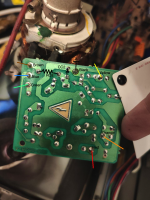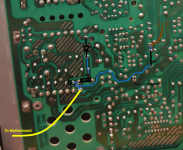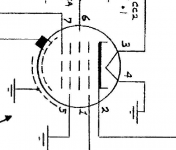benanderson89
Well-known member
I'm now faced with a new problem trying to repair my Macintosh Classic. In a previous thread I thought I had worked out that DP7 had failed since there was a short over the diode. I removed the diode and tested it completely out of circuit. It's fine and works perfectly. There was still continuity between the two now empty pads on the board where the diode used to be, as well as across almost the entire low voltage side of the transformer including every pin on that side of the transformer itself and one of the power rails of the molex connector for the hard disk.
I disconnected everything to remove the board from the chassis and the problem suddenly went away and I was no longer getting shorts to ground across the low voltage side of the analogue board.
Reconnecting everything one by one, I got a short again once I connected the small board to the back of the tube.
I tested the components on the small board with my multimeter and I thought it was CC2 that had failed (a 0.1uF 100v J cap), so I snipped it off. Turns out it was fine and I still get a short to ground. The value was just so low that my cheap meter didn't register it properly.
Does anyone have any idea what on earth (no pun intended) is going on with this?
Cheers!

I disconnected everything to remove the board from the chassis and the problem suddenly went away and I was no longer getting shorts to ground across the low voltage side of the analogue board.
Reconnecting everything one by one, I got a short again once I connected the small board to the back of the tube.
I tested the components on the small board with my multimeter and I thought it was CC2 that had failed (a 0.1uF 100v J cap), so I snipped it off. Turns out it was fine and I still get a short to ground. The value was just so low that my cheap meter didn't register it properly.
Does anyone have any idea what on earth (no pun intended) is going on with this?
Cheers!




